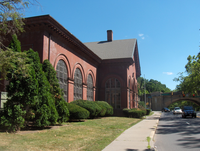User talk:Dthomsen8/PWD
 Philadelphia Water Department logo | |
| Utility overview | |
|---|---|
| Formed | 1801 |
| Jurisdiction | City of Philadelphia, Pennsylvania |
| Headquarters | ARAMARK Tower 1101 Market Street, FL 5 Philadelphia, PA 19107 |
| Employees | 2,000[1] |
| Annual budget | $607,576,000, FY ending 2008-06-31, actual[2] |
| Utility executive |
|
| Website | http://www.phila.gov/water |
The Philadelphia Water Department provides integrated potable water, wastewater, and stormwater services for Philadelphia, Pennsylvania, and some communities in Bucks, Delaware and Montgomery Counties. [3]
The primary mission of the department is the planning, operation and maintenance of both the physical infrastructure and the organized personnel needed to provide high quality drinking water, and to provide an adequate and reliable water supply for all domestic, commercial, and industrial requirements, and to manage wastewater and stormwater to protect and improve the quality of the region’s watersheds, especially the Delaware River and the Schuylkill River.[3]
Drinking water
[edit]
The Water Department draws about half of its water from the Schuylkill River, and about half from the Delaware River. The Queen Lane Plant in East Falls draws water from an intake pumping station (1895) on Kelly Drive. The Belmont Plant on Belmont Avenue in Wynnefield draws water from an intake pumping station (1870-1900) on Martin Luther King, Jr., Drive. [4] The Fairmount Dam prevents brackish water from the Delaware River from coming up the Schuylkill from the Delaware with the tide.[5]
The Baxter Plant draws water from the Delaware River from an intake next to the plant.
See also
[edit]References
[edit]- ^ "Key Statistics about Philadelphia Water Department". LinkedIn. Archived from the original on 2010-08-03. Retrieved 2010-08-03.
- ^ "PWD 2008 Financial Report" (PDF). Philadelphia Water Department. 2008. p. 21. Retrieved 2010-08-03.
- ^ a b "Philadelphia Water Department, Mission". Philadelphia Water Department web site. City of Philadelphia. Archived from the original on 2010-08-01. Retrieved 2010-08-01.
- ^ Gibson, Jane Mork (1990). "Belmont Pumping Station, 1899-1900". Workshop of the World. Oliver Evans Press. Archived from the original on 2010-08-03. Retrieved 2010-08-03.
The City of Philadelphia maintains two pumping stations that draw water from the Schuylkill River—Belmont (1870) and Queen Lane (1895)—both of which are connected to filtration and water purification facilities.
- ^ Gibson, Jane Mork (1990). "Fairmount Dam, 1819-1821". Workshop of the World. Oliver Evans Press. Archived from the original on 2010-08-03. Retrieved 2010-08-03.
Originally constructed for ponding of the river for water supply and for waterpower, Fairmount Dam no longer is needed for waterpower, but it continues to serve the city by providing a water supply storage area for two pumping stations with intakes on the Schuylkill.
